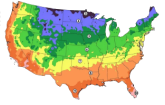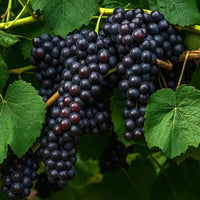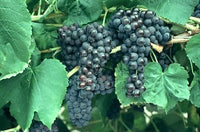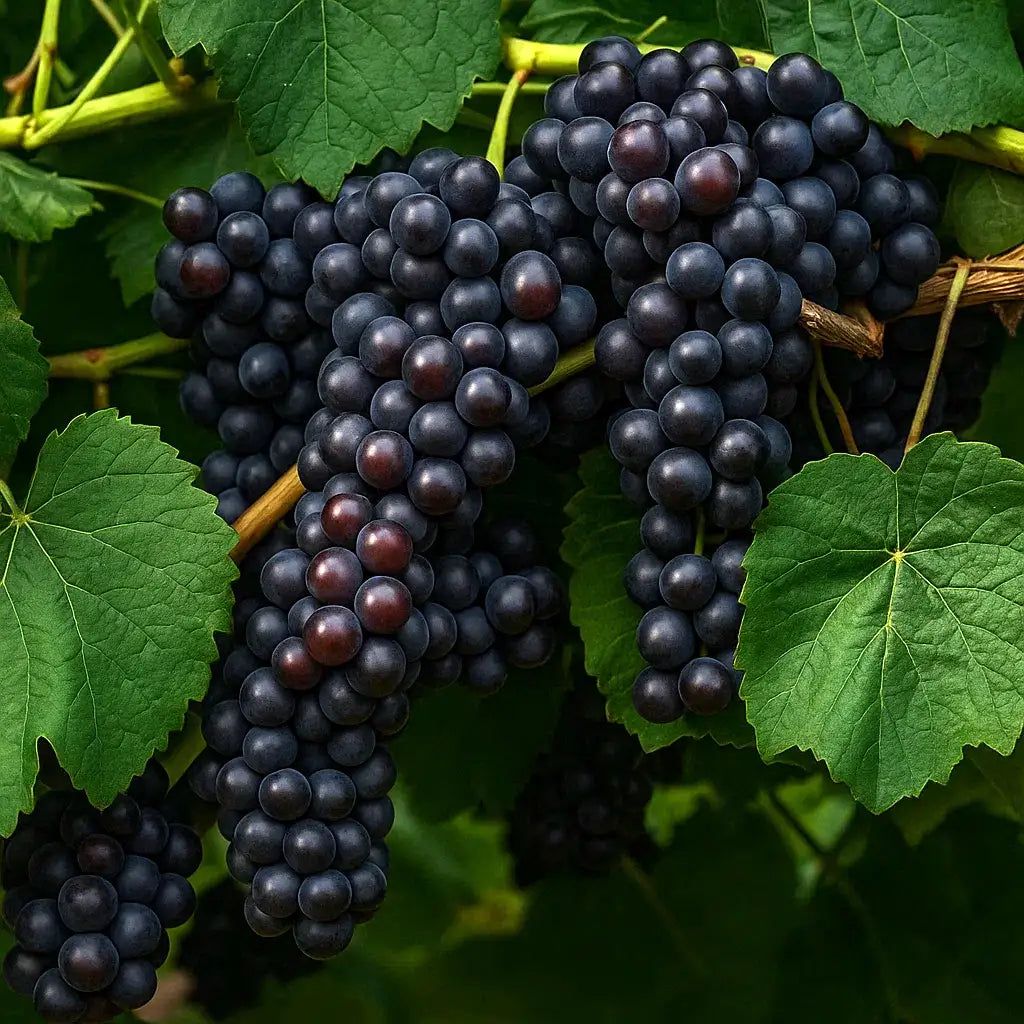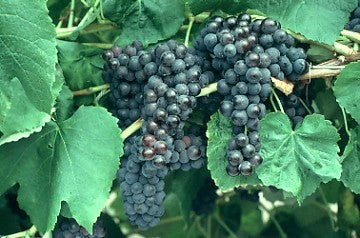Black Monukka Grape Vine
The Black Monukka Grape Vine is a hardy, woody, deciduous vine prized for its seedless, sweet, and flavorful grapes. Known for thriving in warm climates with plenty of sunshine, this variety produces clusters of crisp, dark-purple fruit that are excellent for fresh eating, drying into raisins, or juicing. With its vigorous growth and ornamental appeal, the Black Monukka Grape Vine can be trained along a trellis, arbor, wall, or post, making it both a productive fruit vine and an attractive landscape feature.
Climate & Growing Conditions
This grapevine flourishes in full sun and requires heat for its fruit to fully mature. It performs best in well-draining soil, which helps prevent waterlogging and reduces the risk of fungal disease. When planting multiple vines, space them about 6 feet apart to ensure healthy growth and good air circulation. The Black Monukka is self-fruitful, meaning it does not require another pollinator variety to set fruit.
Watering Requirements
-
Dormant Period (Winter): Do not provide supplemental irrigation during dormancy.
-
Spring: Begin watering once new leaves emerge, about once per week.
-
Summer: Increase to 2–3 times per week during hot weather to maintain vigorous growth and healthy fruit.
-
Fall: Reduce watering as temperatures cool and growth slows.
Pruning Instructions
Pruning is essential for maintaining a productive vine:
-
Winter Pruning: During dormancy, prune back the previous year’s growth. Remove old or unproductive canes and keep healthy new canes for spring growth.
-
Fruit Production: Grapes develop on new canes, making annual pruning critical to encourage flowering and fruiting.
Black Monukka Grape Vine Fertilization
-
Winter: Work manure and organic fertilizers into the topsoil before spring growth begins.
-
Spring: Apply a balanced organic fertilizer with a 1-1-1 or 2-1-1 NPK ratio (e.g., 5-5-5 or 6-3-3) to promote healthy development.
-
Summer: Reapply the growth formula fertilizer to support fruit production.
-
Fall: Avoid high-nitrogen fertilizers. Instead, use a low-nitrogen, high-phosphorus, and potassium formula (e.g., 4-12-12) to harden the vine for the next season.
Pest & Disease Management
-
Fungal Susceptibility: Like many grape varieties, the Black Monukka can be prone to powdery mildew and rust. Ensure good airflow and avoid overwatering to minimize risk.
-
Organic Control: Treat or prevent fungal issues with organic fungicides such as liqui-cop or horticultural neem oil.
Spacing Between Trees:
- Standard-sized fruit trees typically require spacing of 20 to 25 feet between each tree.
- Semi-dwarf varieties may need spacing of 15 to 20 feet, while dwarf fruit trees can be spaced closer, around 10 to 15 feet apart.
- If planting multiple rows of fruit trees, maintain spacing between rows to allow for adequate sunlight penetration and airflow.
- Rows should typically be spaced 25 to 30 feet apart for standard-sized trees, and 15 to 20 feet apart for semi-dwarf and dwarf varieties.
- Consider the mature height and spread of the fruit trees when determining spacing.
- Ensure enough space between trees and other structures to accommodate their growth without crowding.
- Plant fruit trees in rows with the north to south orientation to maximize sunlight exposure on both sides of the trees.
- Avoid planting fruit trees too close to buildings, fences, or other structures, as their roots may cause damage over time.
- Prepare the planting area by loosening the soil and incorporating organic matter to improve drainage and fertility.
- Plant fruit trees at the same depth as they were in the nursery container, ensuring that the graft union (if present) is above the soil level.
Step One:
Soil and Planting: Plant in soil that drains well. Dig a hole that is as deep as the tree’s roots and at least twice as wide.
Step Two:
Place the tree in the hole and backfill around the plant’s roots with a mixture of the native soil and high-quality planting mix that has washed sand and organic fertilizer.
Step Three:
Create a basin around the roots drip zone so that water collects. Water deeply until the roots and nearby soil is saturated and reaches field capacity.
Full Sun Exposure:
- Most fruit trees thrive in full sun, which typically means they need at least 6 to 8 hours of direct sunlight each day.
- Choose a planting location that receives ample sunlight throughout the day, preferably in a spot with southern or western exposure.
- Sunlight is essential for photosynthesis, the process by which plants convert sunlight into energy to fuel growth and fruit production.
- Adequate sunlight promotes healthy leaf development, flowering, and fruit ripening in fruit trees.
- Avoid planting fruit trees in areas with excessive shade from buildings, tall trees, or other structures, as this can inhibit growth and reduce fruit production.
- Trees planted in shaded areas may produce fewer fruits, have slower growth rates, and be more susceptible to diseases and pests.
- Ensure that fruit trees are spaced appropriately to allow sunlight to reach all parts of the tree, including the canopy, branches, and fruiting spurs.
- Prune surrounding trees or shrubs that may shade fruit trees and obstruct sunlight.
- Monitor changes in sunlight exposure throughout the year, as seasonal variations in sun angle and tree foliage can affect light availability.
- Adjust planting locations or prune surrounding vegetation as needed to maintain optimal sunlight exposure for fruit trees.
Establishment Period:
- During the first year after planting, fruit trees require regular watering to establish strong root systems.
- Water newly planted fruit trees deeply and frequently, providing enough moisture to keep the soil consistently moist but not waterlogged.
- In general, fruit trees should be watered deeply once or twice a week, depending on soil type, weather conditions, and tree species.
- Adjust the frequency of watering based on rainfall, temperature, and soil moisture levels to prevent both under-watering and over-watering.
- Water fruit trees deeply to encourage deep root growth and drought tolerance.
- Apply water slowly and evenly to ensure that it penetrates the soil to a depth of at least 12 to 18 inches.
- Use drip irrigation, soaker hoses, or watering bags to deliver water directly to the root zone of fruit trees, minimizing water loss through evaporation and runoff.
- Avoid overhead watering, as it can promote fungal diseases and waste water by spraying foliage instead of reaching the root system.
- Water fruit trees in the early morning or late afternoon to reduce water loss through evaporation and minimize stress on the trees during the hottest part of the day.
- Avoid watering fruit trees during windy or extremely hot conditions, as water may evaporate quickly before it can be absorbed by the roots.
- Monitor soil moisture regularly by checking soil moisture levels with a moisture meter or by conducting a simple soil moisture test using your finger.
- Adjust watering practices based on soil moisture levels and weather conditions to ensure that fruit trees receive adequate moisture throughout the growing season.
- During periods of drought or prolonged dry spells, increase the frequency and duration of watering to prevent drought stress and maintain tree health.
- Consider applying a layer of mulch around the base of fruit trees to conserve soil moisture and reduce water loss through evaporation.
Timing of Fertilization:
- Fertilize fruit trees in early spring, just before new growth begins, to provide essential nutrients for the upcoming growing season.
- Avoid fertilizing fruit trees late in the growing season, as it may stimulate late-season growth that is susceptible to winter damage.
- Choose a balanced fertilizer specifically formulated for fruit trees, such as a 10-10-10 or 12-12-12 NPK (nitrogen, phosphorus, potassium) fertilizer.
- Consider using organic fertilizers, such as compost, aged manure, or organic fertilizer blends, to promote soil health and reduce the risk of chemical buildup.
- Apply fertilizer evenly around the base of the fruit tree, extending beyond the drip line of the branches.
- Avoid placing fertilizer directly against the trunk of the tree, as it may cause root burn or damage to the tree.
- Follow the recommended application rates provided on the fertilizer label or based on the specific needs of the fruit tree species and soil conditions.
- Use caution not to over-fertilize fruit trees, as excessive nitrogen can lead to excessive vegetative growth at the expense of fruit production.
- Water the fruit tree thoroughly after applying fertilizer to help dissolve and distribute the nutrients into the soil.
- Adequate moisture is essential to ensure that the roots can absorb the nutrients from the fertilizer effectively.
- For established fruit trees, fertilize once a year in early spring, unless soil tests indicate a specific nutrient deficiency that requires additional fertilization.
- Young or newly planted fruit trees may benefit from lighter, more frequent applications of fertilizer during the first few years to support growth and establishment.
- Periodically conduct soil tests to assess nutrient levels and pH balance, as well as to determine the specific fertilizer needs of fruit trees.
- Adjust fertilization practices based on soil test results to ensure that fruit trees receive the appropriate nutrients for optimal growth and fruit production.
Timing of Pruning:
- Prune fruit trees during the dormant season, typically in late winter to early spring before new growth begins.
- Avoid pruning fruit trees during periods of active growth or in late fall, as it may stimulate new growth that is vulnerable to winter damage.
- Use sharp, clean pruning tools, such as hand pruners, loppers, and pruning saws, to make clean cuts and minimize the risk of disease transmission.
- Disinfect pruning tools between each tree to prevent the spread of pathogens.
- Remove dead, diseased, or damaged branches to improve the overall health and appearance of the fruit tree.
- Thin out crowded or crossing branches to improve air circulation and sunlight penetration within the canopy.
- Shape the tree to promote an open, well-structured canopy that allows for even fruit production and easy harvesting.
- Begin by removing any dead, diseased, or broken branches, making clean cuts just outside the branch collar (the swollen area where the branch meets the trunk).
- Thin out excessive growth by selectively removing crowded or crossing branches to allow for better light and air distribution.
- Use heading cuts to prune back overly vigorous branches to encourage branching and promote fruiting wood formation.
- Consider the fruiting habit of the tree species when pruning, as some fruit trees produce fruit on spurs (short, stubby branches) while others bear fruit on new growth.
- Train young fruit trees by selectively pruning to establish a strong, well-balanced framework of scaffold branches.
- Encourage outward growth by pruning back inward-growing branches and removing competing leaders to maintain a central leader or open-center shape.
- Different fruit tree species may have specific pruning requirements based on their growth habits, fruiting patterns, and desired form.
- Research the specific pruning needs of the fruit tree species you are growing and tailor your pruning practices accordingly.
- Monitor the fruit tree throughout the growing season for any additional pruning needs, such as removing water sprouts or suckers that may develop.
- Regularly inspect the tree for signs of pests, diseases, or other issues that may require pruning intervention.
- Monitor for Pests:
- Regularly inspect fruit trees for signs of pest infestation, such as chewed leaves, distorted growth, or the presence of insects or larvae.
- Keep an eye out for common fruit tree pests, including aphids, scale insects, mites, caterpillars, and fruit flies.
- Cultural Practices:
- Maintain good cultural practices, such as proper pruning, watering, and fertilizing, to promote healthy, resilient fruit trees that are better able to withstand pest attacks.
- Remove and destroy any fallen fruit, leaves, or other plant debris that may harbor pests or disease pathogens.
- Natural Predators:
- Encourage natural predators of pests, such as ladybugs, lacewings, and predatory wasps, by providing habitat and avoiding the use of broad-spectrum pesticides that may harm beneficial insects.
- Plant flowering plants nearby to attract pollinators and beneficial insects that help control pest populations.
- Physical Barriers:
- Install physical barriers, such as tree wraps or trunk guards, to protect fruit trees from crawling pests like ants and rodents.
- Use floating row covers or netting to exclude flying insects, birds, and other pests from accessing fruit trees.
- Biological Control:
- Consider using biological control methods, such as releasing beneficial nematodes or predatory insects, to target specific pests while minimizing harm to non-target organisms.
- Introduce parasitic wasps, predatory mites, or other natural enemies of pest insects to help control populations without the need for chemical pesticides.
- Integrated Pest Management (IPM):
- Implement an integrated pest management (IPM) approach that combines multiple pest control strategies, including cultural, biological, physical, and chemical methods, to effectively manage pest populations while minimizing environmental impact.
- Monitor pest populations regularly and use thresholds to determine when intervention is necessary, prioritizing the use of non-chemical control methods whenever possible.
- Selective Pesticide Use:
- Use chemical pesticides as a last resort and only when non-chemical methods have proven ineffective or when pest populations exceed acceptable thresholds.
- Selectively choose pesticides that are least harmful to beneficial insects, pollinators, and the environment, and follow label instructions carefully to minimize risks to human health and the ecosystem.


